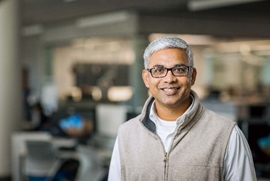检测到您当前使用浏览器版本过于老旧,会导致无法正常浏览网站;请您使用电脑里的其他浏览器如:360、QQ、搜狗浏览器的极速模式浏览,或者使用谷歌、火狐等浏览器。
 下载Firefox
下载Firefox
检测到您当前使用浏览器版本过于老旧,会导致无法正常浏览网站;请您使用电脑里的其他浏览器如:360、QQ、搜狗浏览器的极速模式浏览,或者使用谷歌、火狐等浏览器。
 下载Firefox
下载Firefox
北京大学定量生物学中心学术报告
题 目: Orchestration of Homologous Recombination by DNA binding proteins
报告人: Edwin Antony, Ph.D.
Associate Professor
Saint Louis University School of Medicine
时 间: 3月28日(周一)上午9:00-10:00
地 点: ZOOM线上报告
Meeting ID: 910 9636 7823
Password:cqbcqb
主持人: 齐志 研究员
摘 要:
Lesions, breaks, and errors in DNA are drivers of genomic instability resulting in a variety of cancers. Double-stranded DNA breaks (DSBs) that arise during replication are a particularly severe form of damage that are repaired by the homologous recombination (HR) machinery. Unrepaired DSBs lead to gross chromosomal rearrangements and is a key driver of cancers. HR is a complex process orchestrated by over three dozen protein complexes and mutations in HR genes (eg., BRCA2, RAD51, and RAD52) are prominently identified in genetic diseases and cancers. Proteins in HR serve as attractive targets for inhibitors that sensitize cancer cells to chemotherapy. In this context, blocking HR within cancer cells exacerbates DNA damage and drives them towards cell death. Thus, extensive efforts are dedicated to the identification of synthetic lethal pathways and development of small-molecule inhibitors of HR proteins. Our efforts here focus on obtaining structural knowledge of HR protein complexes to facilitate the development of small molecule inhibitors. RAD51 is the recombinase that binds to single-stranded DNA (ssDNA), forms a filament, and is the enzymatic engine that drives the search for homology. Formation of the RAD51 filament is a critical step and commits the cell to HR. Thus, several mediator proteins regulate this step: Pro-HR mediators such as BRCA2 and RAD52 stabilize the RAD51 filament and foster HR. Anti-HR mediators such as the RECQ and Srs2 helicases dismantle RAD51 from DNA and antagonize or terminate HR. Using cryo-electron microscopy (cryoEM), we have resolved the structures of RAD51 in complex with mediator proteins. Our structures reveal a wealth of knowledge and redraw conventional models of how mediator proteins interact with RAD51 and other HR proteins. A complete model how RPA, Rad52 and Rad51 function together will be presented.
报告人简介:
Edwin Antony obtained his PhD in Biochemistry at Wesleyan University, Middletown, CT. He studied on enzymes that function in DNA repair and recombination and electron transfer. Edwin Antony started his formal research training with rapid-kinetic approaches to study DNA mismatch repair proteins in graduate school with Prof. Manju Hingorani (Wesleyan Univ.), followed by postdoctoral training in live cell fluorescence imaging with Prof. David Yue (Johns Hopkins Univs). He shifted to structural and mechanistic studies of DNA repair proteins with Prof. Tom Ellenberger and Prof. Timothy Lohman (Washington Univ. in St. Louis) and these research endeavors have shaped his independent research program since 2012.
